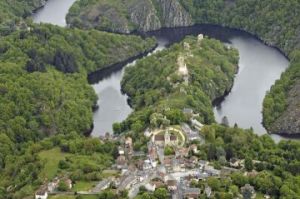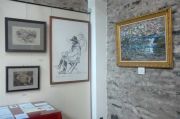 |

|
 Creuse valley © ADRT23 / J.Damase Creuse valley © ADRT23 / J.Damase

|
In 1889, the Creuse valley played host to foremost Impressionist painter Claude Monet who was charmed by its rugged landscapes. This area also inspired many 19th and 20th centuries landscapists who gave birth to an art movement known as Crozant School.
[ Practical ]
Getting there
- By road
340 km from Paris on autoroutes A6b, A10 and A20 till exit 20, then on D36 and D39 till Crozant.
- By train
Teoz train from Paris Austerlitz to La Souterraine. The journey takes between 2 h 40 and 3 h 10. Taxi or car rental from La Souterraine to Crozant, 24 km away.
Lodging
- Hotels
Hôtel du Lac, in Crozant
La Porte Saint Jean, in La Souterraine
Au Bon Cordonnier, in La Souterraine
Château de Fontvieille, in Vareilles
Domaine de Vareilles, in Vareilles
- Bed and breakfast
Mrs Andréa Sackley, in Fresselines
Mr and Mrs Boomkamp, in Fresselines
Restaurants
Auberge de la Vallée, in Crozant
Les Artistes, in Fresselines
Domaine de Vareilles, in Vareilles
Le Passe Muraille in La Souterraine
La Porte Saint Jean, in La Souterraine
Getting around
It’s more convenient to have a car.
Espace Monet Rollinat
Open every day from 2.30pm to 6.30 pm in July and August, on weekends from 2.30pm to 6.30pm in June and September.
Admission : €2.
Hôtel Lépinat
- Adress
5 rue Armand Guillaumin, 23160 Crozant
- Opening dates and hours
July and August : every day from 2pm to 7pm
June and September : Saturday, Sunday and bank holidays from 2pm to 7pm
From October to May : Saturday, Sunday, bank holidays and during school holidays from 2pm to 6pm
Closed from Christmas to February school holidays
Admission : €7 / €5.
- Information
Tel : 0555630190
www.hotel-lepinat.com
Information
- Limousin Tourist Office
Tel : 0555110590
www.tourismelimousin.com
- Creuse Tourist Office
Tel : 0555519323
www.tourisme-creuse.com
- Village of Gargilesse
www.gargilesse.fr
- Pays Dunois Tourist Office
Tel : 0555892461
www.paysdunois.fr
February 1889. Invited by a friend, the art critic Gustave Geffroy, Claude Monet arrives in Fresselines, a small village of the Creuse department. Welcomed by French poet Maurice Rollinat, he spends a week there and quickly falls under the spell of the wild and austere landscapes he discovers. So, he only returns home briefly, in Giverny, in order to grab canvases and brushes, and on March 7th he is back in Fresselines.
 Unchanged landscapes Unchanged landscapes
This second stay lasts nearly three months and during this time he paints 23 canvases including four that were on display at the artist retrospective recently held at the Grand Palais in Paris. Depicting deep valleys, wooded banks, water-mills and trees, they were all created along three rivers - the Sédelle, the Petite Creuse, the Grande Creuse - and at their confluence. These Creuse valley paintings are considered Monet's first true series, having been conceived, executed, and exhibited solely as one ensemble.
More than a century later, the scenery has barely changed except that the 19th century wild rivers have been replaced by quiet waterways as a dam was built in the 20s around ten km downstream, at Eguzon. A path, accessible to everyone, goes along the peaceful banks above all haunted by fishermen and allows following in the painter’s footsteps, passing by the exact spots where he set up his easel.

 Espace Monet Rollinat © T.Joly Espace Monet Rollinat © T.Joly
|
 Exhibition about Monet’s stay Exhibition about Monet’s stay
Only a few miles long and forming a loop, it begins and ends at Fresselines, a small village nestled around a Romanesque church with a curious wooden bell tower. Facing it, on a tiny square stands the house where the artist lived. But, it has been extensively modernized and is not of great interest. It is far more worthy to visit the Espace Monet – Rollinat that is unfortunately only open during the summer season and on a few weekends. On the 1st floor, an exhibition comprising documents, photographs, drawings and copies of paintings done by the painter in Creuse are indeed on display and provide valuable information about his stay and his friend Maurice Rollinat. Besides, on the ground floor there is an exhibition of canvases by artists who presently live or have their studio in the surroundings and perpetuate the long artistic vocation of the region.
Indeed, Claude Monet wasn’t the only one to be attracted and inspired by the landscapes and light in Creuse. From 1830 to 1930 more than 400 painters frequented the area, staying there for short or long periods.
 Hundreds of artists Hundreds of artists
Let’s name Armand Guillaumin, Eugène Charasson, Maurice Leloir, Charles Donzel, Paul Madeline, Clémentine Ballot, Fernand Maillaud, Léon Detroy, Walter Oetten, Allan Osterlind and Francis Picabia. Belonging to various art movements, they all came to the Creuse Valley to paint landscapes in the open air. In 1864, during the Salon de Paris, art critics named this artist colony the “Crozant School”, a reference to one of the villages where they lived. Dominated by the romantic ruins of a powerful medieval fortress and nestled around a 12th century church, it is situated 8 km away from Fresselines, near the confluence of the Creuse and Sédelle rivers where stand the romantic ruins of a powerful medieval fortress. It boasts a recently opened interpretation centre dedicated to the painters of the Creuse valley that is housed in the Lépinat hotel, one of the former favorite inns of the painters. The ground floor recreates the 1900 atmosphere and the Impressionist painters way of life through the reconstruction of the inn and of an artist studio.
 One of France’s most beautiful villages One of France’s most beautiful villages
On the first floor, a few original paintings, reproductions, photographs, interactive tablets and film screenings give visitors an in-depth knowledge of the works produced by Impressionists in this region. The Hotel Lépinat is also the departure point of another trail leading to some spots where the painters set up their easel.
The third artist haven was Gargilesse, 20 km further North, in the Indre department. Classified as "one of the most beautiful villages of France", it is perched on top of a hill overlooking the gorge of a small tributary of the Creuse river and its picturesque houses are clustered around a Romanesque church and a feudal castle. Living 50 km away, at Nohant, famous writer George Sand discovered this place in 1844 and she became so fond of that she came every time she wanted to rest and had a tiny house in here, now a small museum holding her simple furniture, documents and possessions. She also invited many artist friends here contributing to the fame of the area and the development of the Crozant School.
July 01, 2014
Thierry Joly 

|



